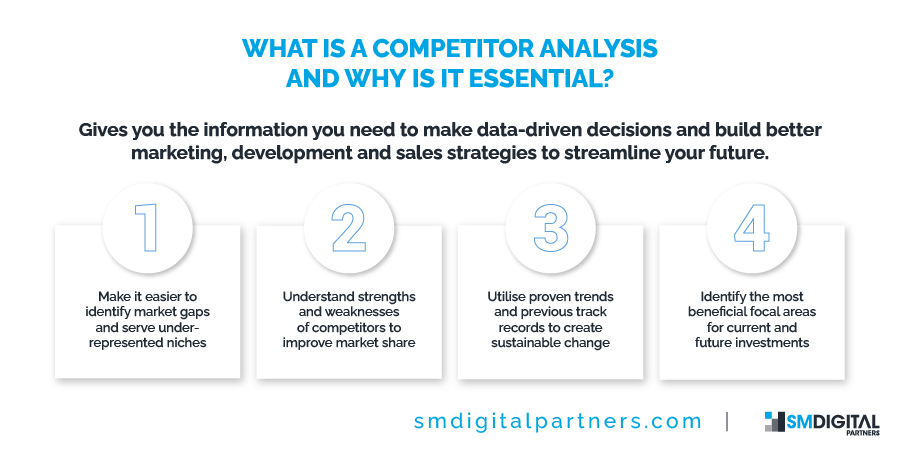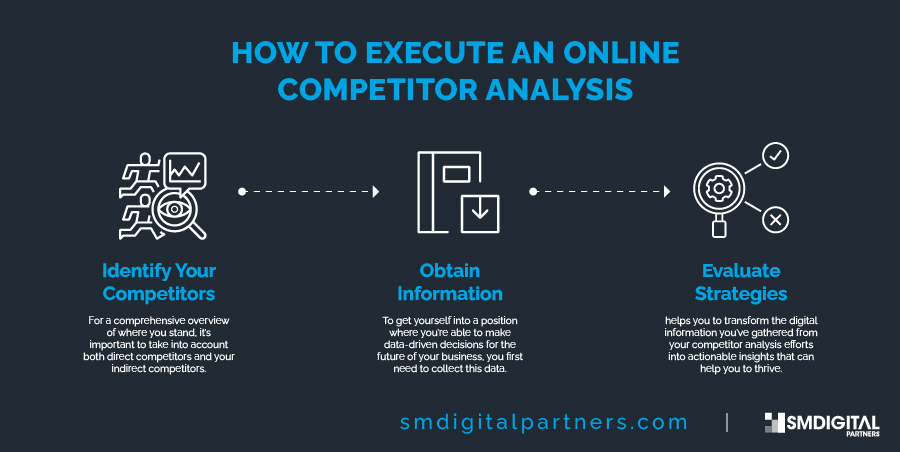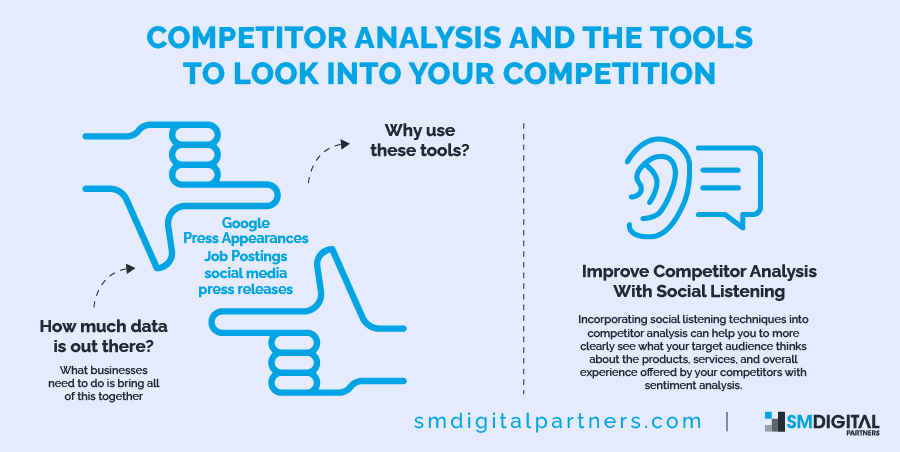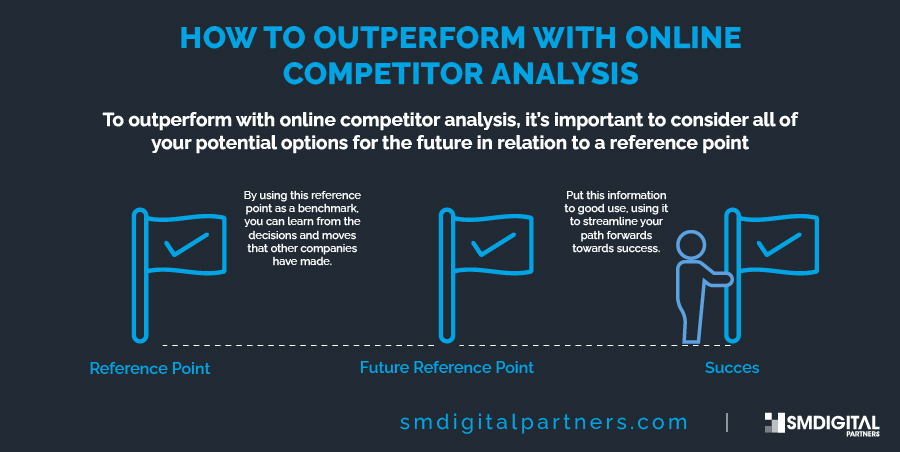
9 Common SEO Mistakes that Content Writers Make
Content is king. At least that’s been the mantra of marketers for several years. Is this
A comprehensive competitor analysis strategy can help your business to answer some of the most unanswerable questions in modern business.

There are a number of vital factors driving success. Among them are an ability to leverage complementary assets, and the timing of entry into the market. But perhaps most importantly of all, according to the research firm, is scale relative to the competition. Competitor analysis shows you where you stand.
A comprehensive competitor analysis strategy can help your business to answer some of the most unanswerable questions in modern business. Why are your competitors performing better than you? What are they doing that makes them favorable in the eyes of your target demographic? What are they doing that lowers brand perception? How are they maintaining their position on the SERPs? And how are they succeeding?
Ultimately, competitor analysis gives you the information you need to make data-driven decisions and build better marketing, development and sales strategies to streamline your future.
A good competitor analysis strategy can:
But why is competitor analysis essential? The truth is that each business will want something slightly different from their efforts. That said, there is one modern challenge that is shared across practically all industries and sectors today: retention.
Research by global management firm Gartner suggests that customer retention is a growing issue, especially in technology where more than one third of organizations cite retention as a major obstacle.
Customer retention is a very serious consideration. In many cases, customers don’t lose their long term needs. The fact that they require solutions to their problems doesn’t change, but what can change is who they choose to provide these solutions. And the reason for change could be anything, from price to experience, to brand reputation.
There are a number of reasons why competitor analysis is useful. One of the most compelling for many organizations is that it can counterbalance cognitive bias in strategic decision making. When businesses are considering launching a new product or service, or taking new opportunities for growth, they can sometimes take an isolated approach without factoring in outside forces or real life practicalities. And this introduces human bias.
When making big decisions for your business, it’s not always best to rely on individual and independent judgement, especially from those closest to the business itself. Instead, it’s important to look at how potential decisions could play out in real life. Have your competitors taken a similar approach? Did it work? Could it have been done better? With competitor analysis, there’s no need to repeat the mistakes of others.
Competitor analysis involves considering your future plans in context; thinking about them in relation to similar plans or ideas that have already been actioned by those operating within your industry, or in complementary sectors. By constantly evaluating your business operations against a benchmark, you can build upon what’s been proven to work in order to gain a competitive advantage and solidify your position.
Competitor analysis and market research are often talked about interchangeably, but they are actually two distinct methods of improving your strategic decision making:
Performing online competitor analysis is to ‘learn from the experience of other companies by collecting case studies of similar decisions to provide a class of reference cases for comparison'

McKinsey states that to perform online competitor analysis is to ‘learn from the experience of other companies by collecting case studies of similar decisions to provide a class of reference cases for comparison’. And there’s a 3-step process for doing so:
Your competitors don’t just include the big names. Be sure to consider emerging players to provide you with the insight you need to counter potential new threats to your market position and share. For a comprehensive overview of where you stand, it’s important to take into account both direct competitors and your indirect competitors.
To get yourself into a position where you’re able to make data-driven decisions for the future of your business, you first need to collect this data. There are multiple sources, including publicly available documents such as annual reports, company profiles, press releases, and product brochures. But depending on what it is you’re hoping to achieve from your competitor analysis efforts, you may also wish to collect the following data:
Content data which may be found within blog posts, case studies, newsletters, images and videos, webinars, podcasts, or paid ads. What gaps could you fill?
SEO data which can provide insight into why your competitors are ranking higher than you in the SERPs. This can help to improve brand awareness and visibility.
Social media listening data such as which networks are utilized, posting schedule, and follower counts. This can help to determine relevant engagement metrics to track.
Once information has been obtained, businesses can take a SWOT approach to creating and evaluating strategies. SWOT – strengths, weaknesses, opportunities, and threats – helps you to transform the digital information you’ve gathered from your competitor analysis efforts into actionable insights that can help you to thrive.

Content is king. At least that’s been the mantra of marketers for several years. Is this

Is SEO important? – You’ve probably heard this question before… This vital digital marketing tool is

Let’s see the answers to the question which is on everyone’s lips – How Does SEO
There are a number of different trends to look out for when conducting competitor analysis. The metrics you choose to measure will largely depend on what exactly you want to achieve through your efforts. However, some good trends to identify are:
Rolling out a full competitor analysis strategy can be a nerve wracking experience, but when you’re using the right tool, keeping track of the competition can be simple – provided you have the know-how to extract the best insight from the data collected.

Perhaps the most obvious starting point is Google. At the most basic level, early stage competitor analysis can be kickstarted by searching for competitor names, or by searching for your own brand name and viewing which other companies are searched for alongside your own. But unfortunately, Google is limited in its ability to support a comprehensive competitor analysis strategy. And that’s because of data overload.
It’s important to consider just how much data is out there and available: digital trade publications, employee interviews and press appearances, advertising copy… And then there are press releases which discuss financial progress, job postings which can hint at new projects or initiatives, and social media which highlights audience perception.
What businesses need to do is bring all of this together. Of course, in terms of value, not all data sources were created equal. But all must be considered for the full picture. And that’s why tools that combine web scraping with social listening methods are best. Good competitor analysis tools help you to track behaviors, analyze actions, and ultimately learn from what your competitors are doing. They should generate information that can be applied directly to product development and campaigns. To ensure this is the case and the most applicable, relevant insight is extracted, a professional in data analysis and research will often be needed.
As competitor analysis has become such an essential tactic in business success, a huge number of tools have been made available, and choosing the right support can sometimes be tricky. What you should be looking for is a multi-use tool that allows you to collect and collate information from multiple sources, listen to your audience, identify trends, and transform insight into action. There are many excellent options out there, including Sprinklr which offers both listening and benchmarking, Talkwalker’s Quick Search, which offers real time competitor activity tracking, and Brand watch which dives deeper into sentiment to measure share of voice and audience perception.
Rolling out a full competitor analysis strategy can be a nerve wracking experience, but when you’re using the right tool, keeping track of the competition can be simple – provided you have the know-how to extract the best insight from the data collected.
As we touched upon earlier, gathering data from social media can be an important part of a comprehensive competitor analysis strategy. Taking a look at competitor posts, audience engagements, and responses to issues and concerns is a good starting point. But it’s not just about how competitors act… it’s about how their customers do.
The benefits of competitor analysis can be enhanced through social listening; through understanding more about what customers actually think of your competitors. Social listening is a way to look at your competitors not from your point of view, but from the point of view of your audience. It can help you to answer questions such as ‘why do customers choose this brand?’ and ‘what would make them want to switch brands?’
Incorporating social listening techniques into competitor analysis can help you to more clearly see what your target audience thinks about the products, services, and overall experience offered by your competitors with sentiment analysis. It can also help you to tune into emerging trends before they become widely apparent, and perhaps discover new brands.
Tuning in to what’s being said can make it easier for you to calculate your share of voice; how much audiences are talking about your business and your brand in comparison to how much they’re talking about others. Of course, share of voice is a tricky subject, with both positive and negative discussions creating a seemingly strong SoV, but by taking into account reputational highs and lows, you get the whole picture.
Social listening can also be effective in reaching out to new demographics and new audiences. It provides insight into the expectations, demands, interests, and requirements of your competitor’s audience base, enabling you to make strategic decisions to appeal and attract these new pools and generate new MQLs and SQLs.

Let’s cut to the chase: Google is eating its own ecosystem. For those of us who’ve

Introduction to Gamification In today’s competitive marketing landscape, engaging your audience requires more than just traditional

Introduction to Voice Search Optimization Voice search technology has rapidly evolved from a futuristic concept to

In recent years, the integration of artificial intelligence (AI) into Google’s search algorithms has revolutionized the

In today’s digital era, successful brands understand that engaging content goes beyond product promotion. By focusing
In today’s digital landscape, choosing the right social media platform can make or break your marketing

In the vast digital landscape of today’s internet, where billions of searches are conducted daily, merely
To outperform with online competitor analysis, it’s important to consider all of your potential options for the future in relation to a reference point.

Although the actual act of competitor analysis can be simple when using the right tool, excelling at the act itself is not enough. It’s the equivalent of creating a new product, and then not actually taking the measures to launch it; it’s pointless. When you have the necessary information, it’s important to act on it, and use it to your advantage.
To outperform with online competitor analysis, it’s important to consider all of your potential options for the future in relation to a reference point. By using this reference point as a benchmark, you can learn from the decisions and moves that other companies have made, and tailor your approach to deliver the very best results.
Work to identify competitive blind spots and discuss how these blind spots can be addressed, and where they fit into your overall strategy. Ultimately, the aim of competitor analysis is not to find out what the competition is doing, it’s to put this information to good use, using it to streamline your path forwards towards success.
And the truth is that, while it may seem simple to gather data using tools, it’s not always as easy to understand how this data applies to your business, and how you can transform it from mere facts and figures into real actionable insights.
That’s why many businesses work alongside an experienced research team, not just facilitating change, but actually implementing it into day-to-day operations and core business processes. It’s massively helpful to get a fresh perspective from an outside professional service. As looked at earlier, viewing the landscape from an isolated viewpoint is not beneficial.
Competitor analysis isn’t a onetime thing. With new businesses entering the market all the time, and customer needs evolving at a rapid rate, data should be collected, analysed, and actioned on a regular basis in order to maintain market position and share of voice, and gain a competitive advantage that will help you thrive in future.

What Do Marketers Think? Our diverse team of marketers gathered to uncover why removing dollar signs

In the dynamic world of digital marketing, where attention spans are fleeting and scrolling is the

Alright, so picture this: you’re running a blog, hustling to churn out fresh content left and

Imagine your website as a bustling city, with each webpage serving as a unique neighborhood. Now,
Unveiling the Key to Sales and Marketing Triumph: The Power of Scoring In the ever-evolving landscape

Want to learn more about how smdigital can help?
Complete the brief form below, and one of our digital experts will reach out to you shortly.

At SMDigital, it’s all about our people, our passion, and performance for our clients! See what we can do for you!
Monday – Friday 9:00AM – 6:00PM, EST
Saturday – Sunday: Closed
Santiago Tobon
stobon@smdigitalpartners.com
US Headquarters
Congress Commerce Center
601 N. Congress Avenue
Delray Beach, FL 33445
Julián Arroyave
jarroyave@smdigital.com.co
Carrera 42 #14 – 11 Piso 5
Edificio Castropol Plaza
Medellin, Colombia S.A.
Grace Bautista
talent@smdigitalusa.com
Jose Maria del Mar St.,
cor. Abad St., Cebu IT Park,
Cebu City 6000, Philippines
Santiago Tobon
stobon@smdigitalpartners.com
US Headquarters
Congress Commerce Center
601 N. Congress Avenue
Delray Beach, FL 33445
Julián Arroyave
jarroyave@smdigital.com.co
Carrera 42 #14 – 11 Piso 5
Edificio Castropol Plaza
Medellin, Colombia S.A.
Grace Bautista
talent@smdigitalusa.com
Jose Maria del Mar St.,
cor. Abad St., Cebu IT Park,
Cebu City 6000, Philippines

At SMDigital, it’s all about our people, our passion, and performance for our clients! See what we can do for you!
Feel free to contact me, and I will be more than happy to answer all of your questions.
Schedule a 30-minute discussion with one of our digital experts. We’ll listen to your challenges and tell you if we can help.